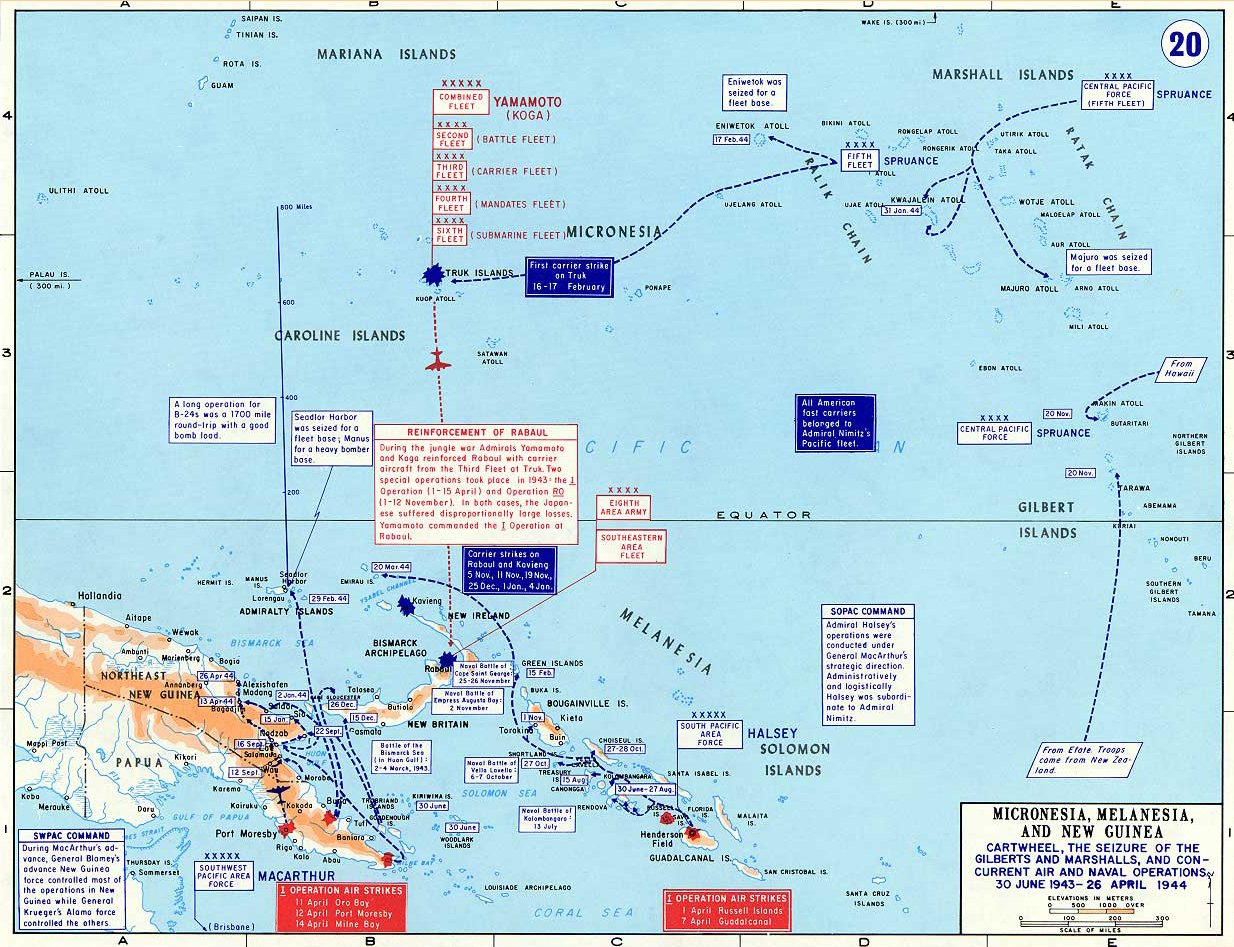Map Description
History Map of WWII: Micronesia, Melanesia, and New Guinea 1943/44
Illustrating:
OPERATION CARTWHEEL
21 June 1943 - 26 April 1944
The Seizure of the Gilberts and Marshalls and Concurrent Air and Naval Operations
Operation Cartwheel (1943–1944) aimed to isolate and neutralize the Japanese stronghold at Rabaul through coordinated
offensives in the Solomon Islands and New Guinea.
Please note: While the Central Pacific offensives — including the seizure of the Gilbert and Marshall Islands — occurred
concurrently and supported the broader Allied strategy, they were not part of Operation Cartwheel. Those operations fell
under Admiral Nimitz’s Central Pacific Drive, distinct from the Southwest Pacific Area (SWPA) campaigns led by General MacArthur.
Cartwheel’s pincer strategy involved leapfrogging along the northern coast of New Guinea and advancing through the central
Solomons to cut off Rabaul and render it militarily irrelevant.
:: Troop Deployments and Command Structure ::
Admiral William Halsey commanded the South Pacific Area (SOPAC), responsible for the Solomon Islands operations, while General
Douglas MacArthur led the Southwest Pacific Area (SWPA), directing the New Guinea campaigns.
Please note: SOPAC was not under MacArthur's direct command. It reported administratively to Admiral Chester Nimitz’s Pacific
Ocean Areas (POA) command but coordinated operationally with MacArthur during Cartwheel. Forces included U.S. Marine and Army units,
along with New Zealand troops operating from bases like Éfaté.
The captures of Majuro (January 31, 1944) and Eniwetok (February 17–23, 1944) were critical to the Central Pacific campaign
but were not part of Operation Cartwheel. These operations, under Nimitz, supported the broader strategy by securing
bases closer to the Marianas and the Philippines.
The seizure of Manus Island in the Admiralty Islands (beginning late February 1944 and completed in March) was part of SWPA
operations and provided Seeadler Harbor, a major forward base for heavy bombers and naval logistics.
Integration of Nimitz’s
fast carrier forces into the broader Pacific effort was demonstrated in Operation Hailstone, the first major carrier strike
on Truk (February 16–17, 1944), which crippled Japanese naval aviation capabilities. This operation was not part of
Cartwheel but aligned strategically by neutralizing a major Japanese base that could threaten Allied advances.
:: Air and Naval Campaigns ::
Allied air operations, led by the U.S. Fifth Air Force and Royal Australian Air Force, targeted Japanese strongholds with
long-range bombing runs, including 1,700-mile round-trip missions by B-24 Liberators from Port Moresby and Milne Bay.
Carrier air strikes on Rabaul (November 5 and 11, 1943) and Kavieng severely damaged Japanese air power and made continued
operations from Rabaul untenable. The Battle of the Bismarck Sea (March 2–4, 1943) marked a turning point, as Allied air
forces decimated a Japanese convoy attempting to reinforce Lae, highlighting the growing effectiveness of air-ground coordination.
Japanese efforts to reinforce or supply Rabaul through Operation I-Go (April 1943) and Operation RO (November 1943) ended
in failure, with heavy aircraft and naval losses.
Operation I-Go was a large-scale aerial counteroffensive ordered by Admiral Yamamoto, while RO was a naval
operation attempting to protect convoys headed toward Bougainville.
:: Key Naval Engagements ::
The Battle of Empress Augusta Bay (November 2, 1943) saw U.S. naval forces repel a Japanese counterattack during landings
at Bougainville, while the Naval Battle of Cape Saint George (November 25–26, 1943) ended in a decisive U.S. destroyer victory,
sinking three Japanese destroyers without loss.
These battles disrupted Japanese destroyer and cruiser operations in the Solomons but did not directly impact Japan’s major
fleet elements. The Japanese Third Fleet (carriers) and Second Fleet (battleships) were not significantly involved in these
areas at this time; they were largely based further west and preserved for later operations (e.g., the Philippine Sea).
The Japanese Fourth Fleet (responsible for the Mandated Islands) and Sixth Fleet (submarines) struggled to counter the
Allies’ momentum and suffered attrition across the theater.
:: Logistics and Outcomes ::
The occupation of Manus Island and the development of Seeadler Harbor as a fleet anchorage solidified Allied supply lines
for future operations. Sustained air and naval pressure gradually rendered Rabaul ineffective by early 1944.
MacArthur’s New Guinea Force under General Thomas Blamey and Alamo Force under General Walter Krueger continued the ground
campaign, leapfrogging past strongpoints and isolating enemy garrisons.
By April 1944, Operation Cartwheel had succeeded in its primary objective: neutralizing Rabaul without a direct assault.
This paved the way for the Central Pacific thrust toward the Marianas and the Philippines, while significantly degrading
Japanese naval and air power in the Southwest Pacific.
Credits
Courtesy of the United States Military Academy Department of History.
Related Links
About the Second World WarWWII Timelines

